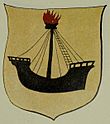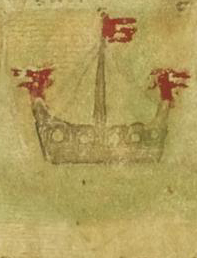John of Argyll facts for kids
Quick facts for kids
John of Argyll
|
|
|---|---|
| Lord of Argyll | |
 |
|
| Reign | 1310–1316 |
| Predecessor | Alasdair de Argyll |
| Died | 1316 Ospringe, Kent, England |
| Noble family | Clan MacDougall |
| Issue | Many, including Eóghan, Ailean, Somhairle, Alasdair Óg |
John of Argyll was an important Scottish nobleman in the early 1300s. He is sometimes called John Bacach, which means "the Lame," but this nickname was not used during his lifetime.
Contents
Early Life and Family Connections
John was the son of Alexander MacDougall, who was the Lord of Argyll. His mother was a daughter of John I Comyn, Lord of Badenoch. Because of his parents' families, John and his relatives supported the House of Balliol in Scottish politics. This loyalty shaped their actions during the Great Cause (a dispute over who should be King of Scotland) and the First War of Scottish Independence.
The MacDougalls and the Comyns of Badenoch were strong supporters of the Balliol family in western Scotland. This put them against other powerful Scottish families who supported Robert the Bruce. These included the Clan Donald, Clan Campbell, the Menteiths, the Lennox family, and the House of Stewart, as well as Bruce's own forces from Carrick.
Conflicts and Loyalty
After King John Balliol was removed from power in 1296, John's father, Alexander, opposed the new rule of King Edward I of England. The struggles over who should be king led to many fights between the MacDougalls and other groups in the West Highlands.
One famous story about John in old Scottish tales is about the death of Cailean Mór, also known as Sir Colin Campbell. Cailean was a relative of Robert the Bruce and a local official (called a "Baillie") in Loch Awe and Ardscotnish. Sometime after September 1296, Cailean died in a fight with John's forces at a place called the "Red Ford," near Loch Awe. Later, in 1299, John's father, Alexander MacDougall, was involved in the death of Alexander Og MacDonald, Lord of the Isles, in Ireland.
Over time, the MacDougall family became more cooperative with King Edward I of England, especially as their rivals became less so. By 1305, John and his father were part of an important advisory group for Edward's representative in Scotland, John of Brittany.
Fighting Robert the Bruce
In 1306, Robert the Bruce, who was the Earl of Carrick, openly rebelled against the English king and declared himself King of Scots. After a setback at the Battle of Methven, King Robert fled west. In 1306, Robert's forces met John's MacDougall army at Tyndrum. In this battle, known as the Battle of Dail Righ ("King's field"), John's forces defeated Robert the Bruce.
The next year, King Edward rewarded John by making him the sheriff of Argyll and the Hebrides. However, John wrote to Edward in 1308, explaining that Robert the Bruce's power was growing stronger, and the MacDougalls were in a difficult position. After a defeat at the Battle of Pass of Brander in 1308, Bruce's forces captured Dunstaffnage Castle, the main home of the MacDougalls.
Later Life and Legacy
John fled to England with his father, while King Robert made peace with some of the MacDougalls who stayed in Scotland. By 1310, John's father, Alexander, had joined him in England. They both attended a royal meeting in Westminster. Even after his father passed away in 1310, John continued to serve the English king.
He was put in charge of English naval forces in the Irish Sea in 1311 and 1314. In 1315, he captured the Isle of Man for the English crown. John began receiving a regular payment from Edward II of England in 1316. In that same year, he died in Ospringe, Kent, while on a religious journey to Canterbury. He left a fellow Scottish exile, Dungal MacDouall, in charge of his will.
John had several sons and daughters, though we don't know who his wife or wives were. Some of his known children include:
- Ewen (Eóghan)
- Alan (Ailean)
- Somhairle
- Alexander (Alasdair) Óg
- Mary (Maire)
He also had another daughter who married a man named Patrick de Graham. John's son, Eóghan, later returned to Scotland with Edward Balliol in the 1330s, when Edward tried to claim the Scottish throne, but this attempt was not successful. The MacDougall family eventually returned to power in Argyll later in the century. John's grandson, through his son Ailean, was known as John Gallda ("the Foreigner") and was recorded as "Lord of Argyll" in 1338.
Images for kids


